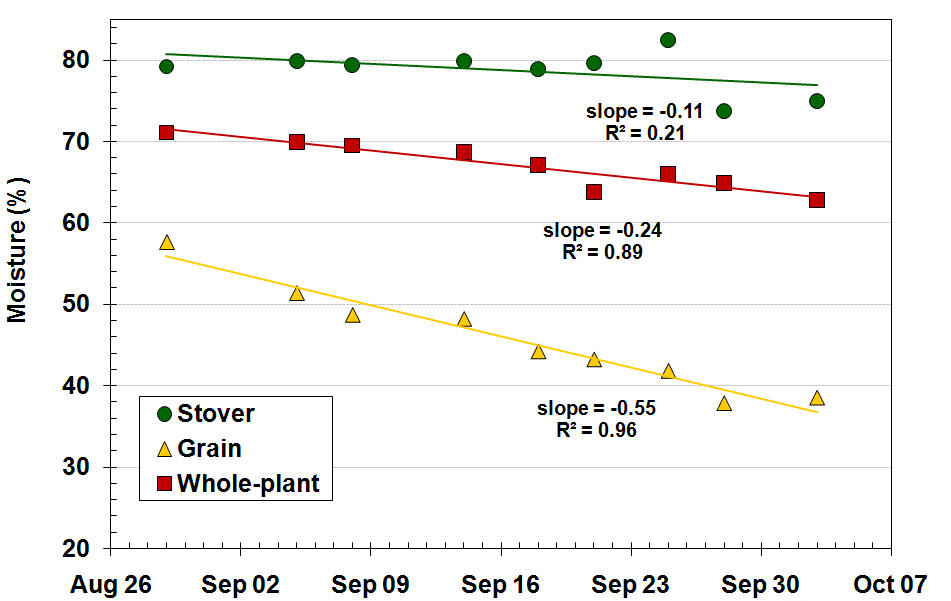
August 19, 2010
Field Crops 28.5 - 80
Synchrony of silage grain and stover drydown
Joe Lauer, Corn Agronomist
This year there is a lot of concern about asynchronous drydown of the
corn silage crop. Farmers are concerned that the grain will get too hard
and be drier than stover when harvested and placed into the storage structure. In
this article I would like to examine, some of the principles behind
timing the decision to begin silage harvest.
From our experience, I would be surprised if corn grain dried
synchronously with corn stover. It does happen in dry years (Figure 1).
But in normal and wetter years, corn stover is wetter (especially at the
base of the stalk) than corn
grain and stover dries at a slower rate (Figure 2). We have observed
asynchronous drydown numerous years and in experiments where we adjust
cutting height.
Most corn silage choppers have kernel processors. Even though corn grain
and stover may have different moistures, when these plant parts are
mixed, moisture will migrate from wetter to drier parts. What is
important to remember is that the whole-plant moisture must be at the
recommended level for the storage structure.
The fact that corn stover and grain plant parts drydown asynchronously
offers farmers a management option. If corn silage is too wet, but the
field must be chopped, then by raising the cutter bar whole-plant silage
moisture will decrease. This could be especially useful when working
with custom operators and timing corn silage chopping. The farmer will
give up some yield although is is the lowest quality part of the plant.
Figure 1.
Moisture change of corn plant parts at Arlington during
2005.

Figure 2.
Moisture change of corn plant parts at Arlington during
2006.

The following in-season guidelines can be used to predict corn silage
harvest date:
- Note hybrid maturity and planting date of fields intended for
silage.
- Note silking date. Half milk of the kernels will typically occur
about 42 to 47 days after silking.
- Once kernel milkline begins to move, measure moisture of fields
intended to be harvested for silage. Use 0.5% per day to predict
date when field will be ready for the storage structure.
- Final check prior to chopping.
- In most years corn stover is wetter than
corn grain at the time of corn silage harvest. Drydown of these plant
parts is usually asynchronous, except in dry years when the drydown rate
is similar between stover and grain. If a custom chopper arrives on the farm and
is pushing to begin chopping and the farmer does not need all of the
forage he is producing, then the cutter-bar of the chopper can be raised
and silage moisture will decrease 2.0 to 3.7 percentage units of
moisture. Remember though that there is a yield v. quality v. moisture
trade-off that will occur as cutting height increases.